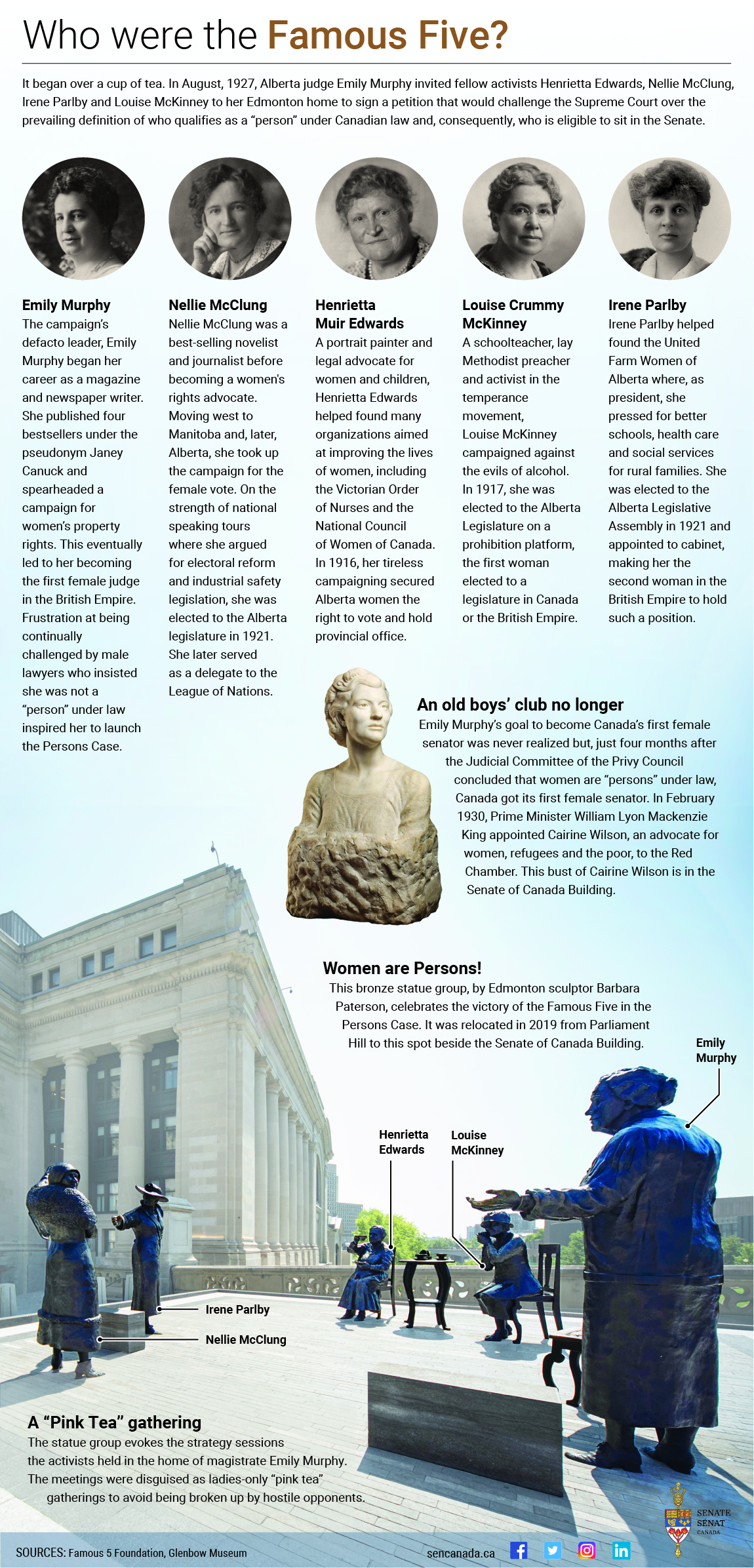Famous Five take prime spot next to Senate building

Disclaimer: The Senate acknowledges that since the writing of this article, social awareness and perspectives on these individuals have evolved, particularly around issues of diversity and inclusion. The Senate acknowledges that these changes in context are important and encourages readers to consider the content in light of the ongoing discussions and evolving social understanding.
Five women who transformed the Senate have a new home next to the Senate of Canada Building.
Though immortalized in bronze, history records the iron will of Emily Murphy, Nellie McClung, Irene Parlby, Henrietta Muir Edwards and Louise McKinney — the Famous Five who took their case across an ocean to ensure that women would be considered “persons” under Canadian law.
The Women Are Persons! monument was installed in 2000 as a tribute to these Alberta women. Originally placed on Parliament Hill, the monument was carefully moved next to the Senate’s temporary home in the summer of 2019 as a result of the rehabilitation of Centre Block.
The women are shown celebrating their famous victory over tea; Ms. McClung brandishes a newspaper proclaiming to the world that Women are Persons.
It’s fitting that they should find themselves next door to the Senate. The Persons Case, as it has become known, was fought in the late 1920s so women could be appointed to the Red Chamber.
Women had finally won the right to run in federal elections in 1921 but no woman had been appointed to the Senate.
The reason? While the Constitution Act, 1867 allowed for the appointment of “qualified persons” to the Senate, the prevailing attitude was that these didn’t include women.
Armed with knowledge of the law — Ms. Murphy was Canada’s first female judge — the five women went to Ottawa to ask the Supreme Court for a constitutional interpretation of this term, which the court duly gave in March 1928.
It went badly.
“There can be no doubt that the word “persons” when standing alone prima facie includes women,” Chief Justice Francis Anglin allowed.
Regrettably, he continued.
“It connotes human beings — the criminal and the insane equally with the good and the wise citizen,” he said. “Hence the propriety of the restriction placed upon it by the immediately preceding word ‘qualified’ … which exclude the criminal and the lunatic or imbecile as well as the minor.
“Does this requirement of qualification also exclude women?”
The court’s answer was unanimous — a definitive yes. Women belonged in the same category as criminals and children, and weren’t fit to be appointed to the Senate.
But the Famous Five weren’t beaten yet. In those days, there was a power higher than the Supreme Court — the Judicial Committee of the Privy Council of England.
So they took their case across the Atlantic Ocean and on October 18, 1929, Lord Sankey — the Lord Chancellor himself — delivered the decision they had long sought.
While acknowledging that politics had historically been the domain of men, Lord Sankey described Canada’s Constitution as “a living tree capable of growth and expansion.”
“The exclusion of women from all public offices is a relic of days more barbarous than ours,” he said. “To those who ask why the word should include females, the obvious answer is why should it not.”
The very next year, on February 15, 1930, Cairine Wilson became Canada’s first female senator.
The proximity of the Famous Five monument to the Senate highlights a key role of the Red Chamber —giving voice to underrepresented groups.
At the end of the 42nd Parliament, women accounted for 49 of the Senate’s 105 seats. They hold crucial leadership roles on Senate committees and within parliamentary caucuses and groups.
Tourists and history buffs now flock to the monument to take pictures and pose with the Famous Five — and to reflect on the great power that every citizen possesses to change their country for the better.
In February 2019, the Senate moved to the Senate of Canada Building, a former train station built in 1912. The Senate is expected to occupy its temporary location for at least 10 years while Parliament’s Centre Block — the Senate’s permanent home — is rehabilitated.
Although Centre Block is shuttered for rehabilitation work, Canadians can still experience its art and architecture through the Senate’s immersive virtual tour.



